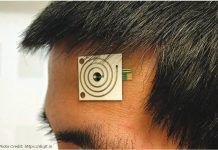 Scientists have used gelatinous hydrogel to create an inexpensive new type of biochemical hydrogel sensor that is highly sensitive, sturdy, long-lasting, and has few moving parts.
Scientists have used gelatinous hydrogel to create an inexpensive new type of biochemical hydrogel sensor that is highly sensitive, sturdy, long-lasting, and has few moving parts.
The gel expands or contracts according to the acidity of its environment, a quality that allows the hydrogel sensor to measure changes in pH down to one one-thousandth on the pH scale. This amount of accuracy, along with its robustness, could make it ideal for chemical and biological applications such as environmental monitoring in waterways and glucose monitoring in blood.
Developed at Indiana’s Purdue University, the hydrogel sensor is formed into a series of raised stripes known as a “diffraction grating,” separated by lower-lying spaces. Both the stripes and the spaces are covered in separate coatings of gold. As the gel expands and contracts according to acidity in its environment, the pattern of stripes and spaces changes. When a laser is shone on the hydrogel sensor, changes in that pattern cause the reflection of the laser light to be diffracted differently. The hydrogel sensor measures change in the diffraction and from that deduces pH levels.
“Many sensors being developed today are brilliantly designed but are too expensive to produce, require highly skilled operators and are not robust enough to be practical,” said Cagri Savran, an associate professor of mechanical engineering at Purdue. “As with any novel platform, more development is needed, but the detection principle behind this technology is so simple that it wouldn’t be difficult to commercialize.”
Savran also stated that the hydrogel sensor could be made even more sensitive, and that they could be designed to measure things other than pH by using other hydrogels that respond to different types of stimuli.



